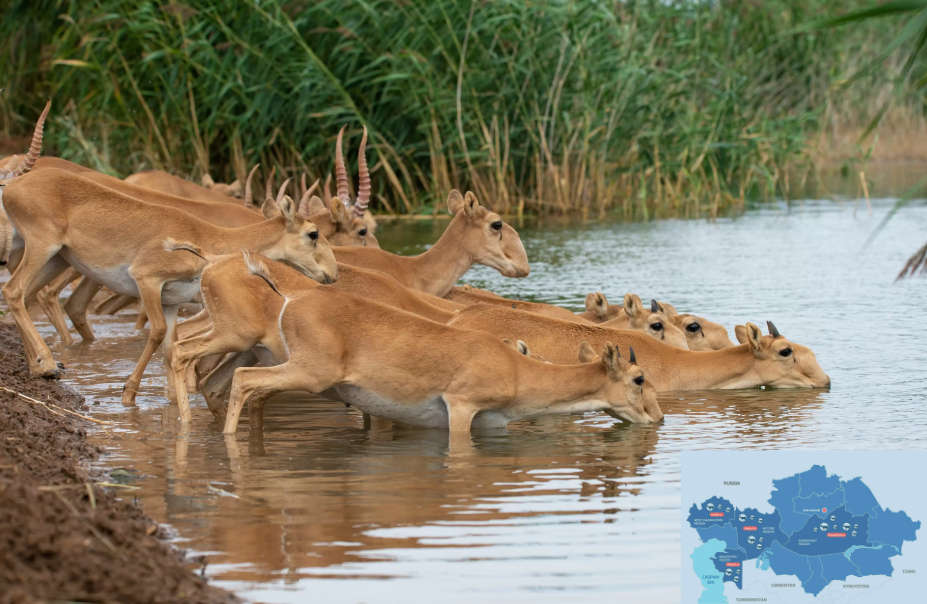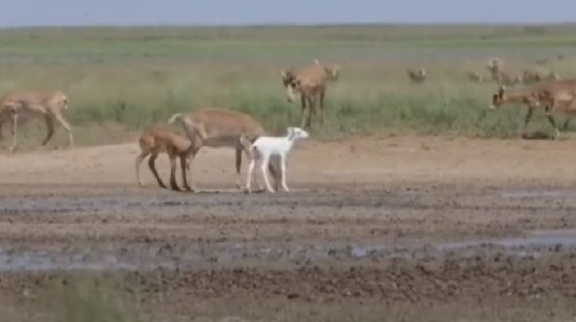NUR-SULTAN – President Kassym-Jomart Tokayev addressed the Kazakh Ministry of Ecology, Geology and Natural Resources at the July 14 expanded government meeting asking them to consider the problem of saiga regulation carefully, reports the presidential press service.

Being a migratory species, saiga lives in large herds, usually up to 1,000 individuals. Photo credit: wwf.ru. Click to see the map in full size
He called the saiga, which is a small antelope with distinctive short trunks, a “sacred animal” for the Kazakh people. The saiga is a small cloven-hoofed animal with a body length of around 110-146 centimeters and a weight of approximately 23-40 kilograms.
The saiga is easily recognizable by its humped nose. The males have horns growing up to 30 centimeters. It is a migratory animal that easily covers long distances and can swim across small bodies of water.
“There is a proposal to eliminate 80,000 saigas, which means to kill them. There are, apparently, other methods. Consult with experts as these are desperate measures. I do not exclude that we might be forced to do it. But, I stress, this is an extreme measure. It is necessary to properly examine this question,” said Tokayev.
The saiga is an endangered species. Since 1996, the saiga has been included in the IUCN’s (International Union for Conservation of Nature) Red List and since 2002, it is listed as a critically endangered species. Since 1999, Kazakhstan has banned saiga hunting except for scientific use and extended the prohibition six times.

Saiga was depicted on the postage stamp of Kazakhstan in 2013. Photo credit: Wikipedia
Overall, 95 percent of the world’s saiga population is concentrated in Kazakhstan, while the remaining 5 percent inhabit Russia and Mongolia.
To date, the country hosts 489,000 Betpakdaly saigas in central Kazakhstan, 28,000 Ustyurt saigas in Mangystau and Aktobe Regions, and 801,000 Uralsk saigas in the West Kazakhstan Region. The population of animals had increased significantly over the past two years, reaching 1,318,000 in April.
The annual growth rate of the population is quite high – approximately 35-40 percent of the population.
Impact of increasing saiga species on agricultural producers
The regulation of saiga growth is now widely debated in Kazakh society because the growth of the animal population began to have a negative impact on the rural economy.
On July 7, representatives of the Kazakh Institute of Zoology, Ministry of Ecology, Geology and Natural Resources, Veterinary and Biotechnology Research Center, local farmers, as well as ecologists from the Association for the Conservation of Biodiversity of Kazakhstan (ACBK) and Association of Practising Environmentalists gathered to discuss the regulation of the saigas’ number.

A fragment from video, where a baby saiga with white wool was was grazing with other individuals in Kazakh steppes in May. Photo credit: Qazaq Expedition Club’s Instagram
In June, farmers stated they are afraid to lose nearly 50 percent of the crop as saigas move onto their fields.
“Last year I lost 8,200 hectares. This year, the damage will be more, because there are more species. Every morning I go to safflower fields and I capture on video tens of thousands of saigas there. I have already plowed 2,000 hectares this year and nothing will grow there,” said АgroMarTrade company head Magomed Dzeitov during the meeting.
According to Zoology Institute’s Theriology Laboratory Head Alexey Grachev, the mismatch between the saigas’ number and the available food supply, open conflict with farmers and significant damage to the rural economy necessitate regulation of the saiga numbers.
In their turn, zoologists noted that saiga population’s growth might cause epizootic, a disease affecting animals of one kind at the same time. Once in 2015, the country lost a record number of 150,000 Betpakdaly saigas because of this infection.
How to regulate the saigas’ population
Natural scientist Saken Dildakhmet was among those participants, who proposed ways to solve the issue.
He said that the number of 1.3 million saigas is not a figure that can be regulated today, therefore it is necessary to increase the number to two or three million to take the action further.
“I believe it is better to mix and resettle the population rather than shoot, because the population of Betpakdaly saiga is nearly 5,000 species, while the population of Ustyurt saigas almost does not grow,” Dildakhmet shared his opinion.
Grachev agreed with Dildakhmet about the Ustyurt saigas number, adding that there are no laws which regulate the hunting of animals and their horns. The optimal number of saiga population taking into account human impact has not yet been defined.
Grachev proposed to extend the current ban on saiga hunting until 2025 and task the Okhotzooprom national company, which is in charge of environmental protection, to regulate the animal numbers.
Even though the current situation has severe risks both for farmers and the saiga population itself, the problem was completely different after the collapse of the Soviet Union.
Conservation of the saigas species
According to ACBK, the number of animals in the country decreased by 50 times from one million to slightly more than 20,000 between 1992 and 2003 due to intensive hunting and poaching.
Since 2004, the number has been gradually increasing due to environmental protection measures.

Map of ungulate migration prepared by the University of Wyoming and University of Oregon in 2018. Photo credit: cms.int
One of them is now being implemented by ACBK. They collect data on saiga migration routes, which will be included in the world’s first Global Atlas of Ungulate Migration. The document featured information on 48 ungulate individuals and is expected to be released in 2023.
The leading specialist at the ACBK Saiga Study Department Albert Salemgareyev said in an interview with The Astana Times that saigas are extremely important for the steppes.
“They play an important role in our ecosystem as steppes need grazing. The saiga antelopes feed on plants and transport them, so that the grass becomes shorter. In this way, they create a favorable environment for rodents and birds who need low grass,” Salemgareyev said.
Sustaining traditional migration routes is considered a crucial issue not only due to saigas’ role in Kazakhstan, but across the globe.
“Migration is also important for predators, for whom saiga serves as a feeding base. These animals are an important part of the food chain. If saiga will not be able to migrate, then other animals will not be able to migrate too,” Salemgareyev noted.


